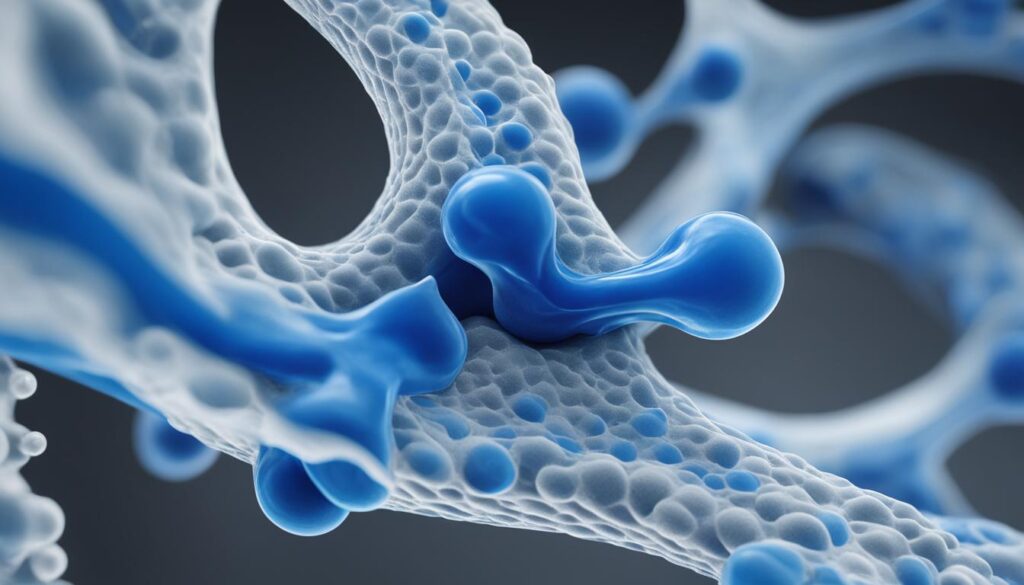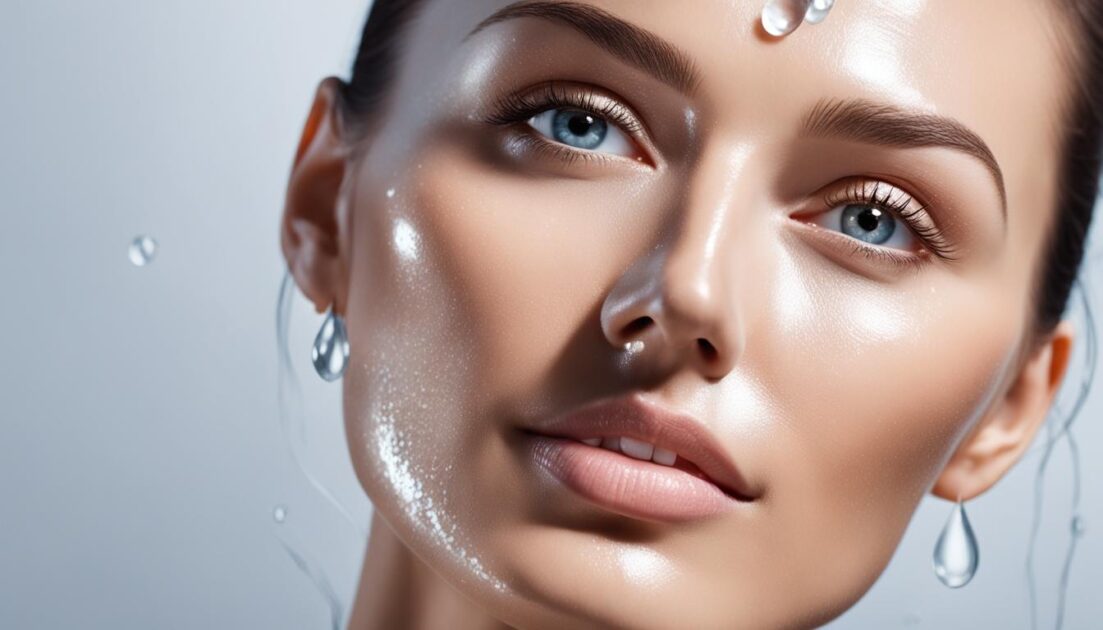Hyaluronic acid has emerged as a standout and crowd favorite in the skincare world. It is considered one of the most effective and readily available skincare ingredients. Hyaluronic acid is a key molecule in skin hydration and tissue repair, attracting and retaining moisture to improve skin flexibility and plump up skin cells. It offers benefits such as increased skin elasticity, reduced appearance of fine lines and wrinkles, and a dewy complexion. Hyaluronic acid is suitable for all skin types and conditions and can be seamlessly incorporated into a skincare routine.
Key Takeaways
- Hyaluronic acid is a highly effective and popular skincare ingredient.
- It improves skin hydration, elasticity, and reduces the appearance of fine lines and wrinkles.
- Hyaluronic acid is suitable for all skin types and can be easily incorporated into a skincare routine.
- It is a versatile ingredient commonly found in serums, moisturizers, and creams.
- When combined with niacinamide, hyaluronic acid provides even more benefits for the skin.
The Role of Hyaluronic Acid in Skin Hydration
Hyaluronic acid is a key player in maintaining optimal skin hydration. As a humectant, it attracts and retains water molecules, helping to prevent moisture loss and keep the skin supple and moisturized. This essential function of hyaluronic acid contributes to its ability to improve the overall appearance and texture of the skin.
One of the notable benefits of hyaluronic acid is its temporary plumping effect on the skin. By drawing in moisture, it can help smooth out fine lines and wrinkles, giving the skin a more youthful and revitalized look. This makes hyaluronic acid a popular ingredient in moisturizers, serums, and other skincare products.
Regardless of skin type or condition, hyaluronic acid is suitable for everyone. For individuals with dry skin, it provides much-needed hydration, alleviating dryness and flakiness. On the other hand, it also benefits those with oily skin by promoting balance and preventing excess oil production.
Furthermore, hyaluronic acid contributes to skin flexibility and elasticity. It helps improve the skin’s ability to bounce back, making it more resilient to environmental stressors and reducing the appearance of sagging or dullness.
Beyond its role in skin hydration, hyaluronic acid also plays a part in wound healing. It aids in tissue repair and regeneration, making it an essential component for overall skin health.
Overall, hyaluronic acid is a powerhouse ingredient that offers numerous benefits for skincare. Its ability to provide intense hydration, plump the skin, and improve flexibility makes it a must-have for anyone looking to achieve healthy and radiant skin.
The Anti-Aging Wonders of Hyaluronic Acid

Hyaluronic acid is a skincare ingredient that offers remarkable anti-aging benefits, particularly in reducing the appearance of fine lines and wrinkles. With its unique hydrating properties, hyaluronic acid is known to plump up skin cells, resulting in a smoother and more youthful complexion.
By improving skin elasticity, hyaluronic acid plays a key role in reducing the visible signs of aging. As we age, our skin’s natural hyaluronic acid levels decrease, leading to a loss of moisture and firmness. However, by incorporating hyaluronic acid into our skincare routines, we can effectively combat these issues and achieve a more rejuvenated appearance.
One of the reasons hyaluronic acid is highly regarded in the beauty industry is due to its ability to attract and retain moisture. This moisture-binding property helps to restore and maintain optimal hydration levels in the skin, resulting in a plumper and fresher complexion.
“Hyaluronic acid is a game-changer when it comes to anti-aging skincare. Its ability to hydrate and plump up the skin can significantly reduce the appearance of wrinkles and fine lines, giving you a more youthful and radiant look.”
Besides its direct anti-aging effects, hyaluronic acid also offers other benefits that contribute to overall skin health. It helps to improve the skin’s texture, making it smoother and more evenly toned. Additionally, hyaluronic acid aids in reducing redness and inflammation, making it suitable for those with sensitive or irritated skin.
The Science Behind Hyaluronic Acid’s Anti-Aging Properties
Hyaluronic acid works by attracting and binding to water molecules, resulting in improved hydration within the skin. By maintaining optimal moisture levels, it helps to plump up the skin cells, smoothing out fine lines and wrinkles. This process also helps to restore the skin’s natural barrier function, protecting it from external stressors.
As one of the most versatile skincare ingredients, hyaluronic acid is found in various anti-aging products, including serums, moisturizers, and creams. Its lightweight texture makes it suitable for all skin types, from dry to oily, and it can be seamlessly integrated into any skincare routine.
With its proven ability to reduce the signs of aging, hyaluronic acid has become a staple in the pursuit of youthful, radiant skin. Incorporating hyaluronic acid into your skincare routine can help you achieve a more youthful and rejuvenated complexion, giving you the confidence to put your best face forward.
The Versatility of Hyaluronic Acid

In addition to its hydrating and anti-aging benefits for the skin, hyaluronic acid is also used for joint health. It helps lubricate joints and provides cushioning, reducing discomfort and improving mobility. Hyaluronic acid is a versatile ingredient that can be found in various skincare products, including serums, moisturizers, and creams.
One of the remarkable properties of hyaluronic acid is its ability to attract and retain moisture, making it an essential component in skincare routines. By binding to water molecules, hyaluronic acid moisturizes the skin, resulting in a plumper and more youthful appearance. Its moisture-locking abilities help to combat dryness, leaving the skin smooth and supple. Additionally, hyaluronic acid promotes the synthesis of collagen, a crucial protein for maintaining skin firmness and elasticity.
The Benefits of Hyaluronic Acid for Joint Health
Hyaluronic acid is not only beneficial for skincare but also plays a vital role in supporting joint health. As a natural component of the synovial fluid that surrounds joints, hyaluronic acid acts as a lubricant, reducing friction and easing joint movement. It also acts as a shock absorber, providing cushioning to protect the joints from impact and stress. By maintaining joint hydration and supporting cartilage health, hyaluronic acid helps to alleviate discomfort and improve joint flexibility.
Whether it’s for your skin or joint health, hyaluronic acid offers impressive benefits. Its versatility as an ingredient makes it a popular choice in both skincare and joint care products. By incorporating hyaluronic acid into your daily routine, you can enjoy the hydrating and rejuvenating effects it brings to your skin and the relief it provides to your joints.
| Hyaluronic Acid Skincare Benefits | Hyaluronic Acid for Joint Health |
|---|---|
| Hydrates the skin | Lubricates joints |
| Improves skin elasticity | Reduces joint discomfort |
| Reduces fine lines and wrinkles | Improves joint flexibility |
| Plumps up skin cells | Provides cushioning to joints |
How to Incorporate Hyaluronic Acid into Your Skincare Routine

To seamlessly incorporate hyaluronic acid into your skincare routine, follow these simple steps:
- Cleanse and tone your skin using your favorite cleanser and toner.
- Apply a dedicated hyaluronic acid product, such as a serum, to your damp skin. This will help to lock in moisture.
- Massage the hyaluronic acid serum onto your face using gentle, upward motions. Focus on areas that need extra hydration, such as dry patches or fine lines.
- Allow the hyaluronic acid to fully absorb into your skin for a few minutes.
- Once the serum is absorbed, follow up with your daily moisturizer. This will help to seal in the hyaluronic acid and provide additional hydration.
- If desired, you can also layer other skincare ingredients on top of the hyaluronic acid serum. For example, you can apply a retinol cream or a vitamin C serum after the hyaluronic acid for added benefits.
- Continue with the rest of your skincare routine, including sunscreen during the day.
By incorporating hyaluronic acid into your skincare routine, you can enjoy its moisturizing and skin-hydrating benefits, helping to keep your skin plump, hydrated, and youthful-looking.
Table: Different Hyaluronic Acid Formulations for Different Skin Types
| Formulation | Skin Type |
|---|---|
| Water or Gel-based | Oily or Combination |
| Richer Cream or Oil-infused | Dry or Mature |
What to Look for in Hyaluronic Acid Products

When it comes to choosing the right hyaluronic acid products for your skincare routine, it’s important to consider a few key factors. By understanding what to look for, you can ensure that you’re getting the most out of this powerful ingredient.
Efficacy over Concentration
While the concentration of hyaluronic acid may seem important, it’s not the sole determining factor of a product’s effectiveness. Instead, focus on finding formulations that contain hyaluronic acid, hydrolyzed hyaluronic acid, or sodium hyaluronate. These different forms of hyaluronic acid offer various benefits for your skin, such as improved hydration and plumping effects.
Pairing with Occlusive Ingredients
To maximize the benefits of hyaluronic acid, look for products that pair it with occlusive ingredients. Occlusives, such as petrolatum or shea butter, create a protective barrier on the skin, locking in the moisture drawn by hyaluronic acid. This combination helps to keep your skin hydrated and supple for longer periods of time.
Understanding Molecular Weights
Not all forms of hyaluronic acid are created equal. Different molecular weights can influence the way hyaluronic acid interacts with your skin. Higher molecular weight hyaluronic acid molecules may provide more surface-level hydration, while lower molecular weight molecules can penetrate deeper into the skin, delivering more intense moisture. Consider products that contain a combination of different molecular weights for optimal results.
“Choosing hyaluronic acid products with different forms and molecular weights can provide a well-rounded approach to skincare, addressing multiple skin concerns and ensuring maximum hydration.”
| Benefits | Hyaluronic Acid Injections | Hyaluronic Acid Supplements |
|---|---|---|
| Increased skin hydration | Yes | No |
| Reduction in fine lines and wrinkles | Yes | No |
| Improved skin elasticity | Yes | No |
| Boosted collagen production | Yes | No |
When incorporating hyaluronic acid into your skincare routine, keep these considerations in mind to ensure that you’re selecting products that will deliver the best results for your skin. By choosing the right hyaluronic acid formulations, you can experience the full range of benefits and achieve radiant, healthy skin.
Common Misconceptions about Hyaluronic Acid

Hyaluronic acid is often mistakenly perceived as an exfoliating agent due to its name. However, it is a hydrating ingredient that works best when sealed with a moisturizer. Another misconception is that hyaluronic acid should not be used in dry environments, but it can still hydrate the skin even in arid conditions. The use of hyaluronic acid skincare products is suitable for all environments and climates.
Despite its name, hyaluronic acid is not an exfoliating agent. In fact, it is an excellent hydrating ingredient that helps to attract and retain moisture in the skin. Hyaluronic acid acts as a humectant, drawing in water and preventing moisture loss, which helps to keep the skin hydrated and plump. However, it is important to note that hyaluronic acid is most effective when sealed with a moisturizer, as this helps to lock in the drawn moisture and provide long-lasting hydration. So, if you’re looking for a product to exfoliate your skin, hyaluronic acid may not be the best choice.
Another common misconception is that hyaluronic acid should not be used in dry environments. However, hyaluronic acid can still provide hydration even in arid conditions. It works by attracting moisture from the environment and binding it to the skin, helping to replenish and moisturize dry skin. So, whether you live in a humid or dry climate, hyaluronic acid can still benefit your skin.
It is also important to note that hyaluronic acid skincare products are suitable for all environments and climates. Whether you live in a hot and humid climate or a cold and dry one, hyaluronic acid can help to hydrate and nourish your skin. Its versatile nature makes it a popular choice among skincare enthusiasts worldwide.
To debunk these misconceptions, it is crucial to understand the true benefits and functions of hyaluronic acid in skincare. By incorporating hyaluronic acid products into your routine and dispelling these myths, you can unlock its true potential for moisturizing and hydrating the skin, regardless of your climate or environment.
Safety and Potential Side Effects of Hyaluronic Acid

Hyaluronic acid is a widely used skincare ingredient known for its numerous benefits. However, it is important to understand the potential side effects and safety considerations when incorporating hyaluronic acid into your skincare routine.
Most individuals tolerate hyaluronic acid well, experiencing no adverse reactions. However, some people may experience mild side effects such as stinging or redness upon application. These reactions are usually temporary and subside quickly.
It is worth noting that overuse of hyaluronic acid can potentially dry out or irritate the skin. Therefore, it is crucial to use hyaluronic acid products in moderation and follow the recommended usage guidelines provided by the manufacturer.
Listening to your skin’s needs is essential. If you notice any discomfort, dryness, or irritation after using hyaluronic acid, consider reducing the frequency or concentration of the product. Additionally, consulting with a dermatologist is advised for individuals with sensitive or reactive skin.
Key Takeaways:
- Hyaluronic acid is generally safe for most individuals, but some may experience mild side effects such as stinging or redness.
- Overuse of hyaluronic acid can potentially dry out or irritate the skin, so it is important to use it in moderation.
- Pay attention to your skin’s reactions and adjust the frequency or concentration of hyaluronic acid products accordingly.
- If you have sensitive or reactive skin, consult with a dermatologist before incorporating hyaluronic acid into your skincare routine.
| Pros | Cons |
|---|---|
| Provides intense hydration | Potential for mild side effects |
| Improves skin texture and plumpness | Possible skin dryness or irritation with overuse |
| Enhances skin flexibility and elasticity | Requires moderation in usage |
| Can be used by all skin types |
The Transformative Properties of Niacinamide

Niacinamide, also known as Vitamin B3, offers a range of benefits for the skin. This powerful ingredient has gained recognition for its ability to address multiple skin concerns and promote a healthy complexion. Let’s explore the transformative properties of niacinamide and how it can benefit your skincare routine.
For individuals with oily or acne-prone skin, niacinamide can be particularly beneficial. It helps regulate sebum production, minimizing excess oil and shine. By controlling oiliness, niacinamide supports a balanced complexion, reducing the risk of breakouts.
In addition to its oil-regulating properties, niacinamide also possesses brightening properties. This makes it effective in fading dark spots and hyperpigmentation, resulting in a more even skin tone. The brightening effect of niacinamide can give your skin a youthful and radiant appearance.
Furthermore, niacinamide exhibits anti-inflammatory properties, making it suitable for soothing and calming irritated skin. Whether you experience redness, sensitivity, or inflammation, niacinamide can help alleviate these concerns, promoting a healthier and more comfortable complexion.
With its remarkable abilities, niacinamide has become a staple in many skincare formulations. Its versatility and compatibility with different skin types make it an ideal ingredient for a wide range of individuals seeking to improve their skin’s overall health and appearance.
Niacinamide Skincare Benefits
| Skincare Benefits |
|---|
| Regulates sebum production, suitable for oily skin |
| Reduces the appearance of dark spots and hyperpigmentation |
| Has anti-inflammatory properties, soothing irritated skin |
When incorporating niacinamide into your skincare routine, look for products that contain an appropriate concentration of this ingredient for optimal results. As always, it’s recommended to patch test new products and consult with a dermatologist if you have any specific concerns or conditions.
By harnessing the transformative properties of niacinamide, you can achieve a healthier and more radiant complexion. Whether you’re dealing with oily skin, hyperpigmentation, or inflammation, niacinamide offers a versatile solution for improving your skin’s overall health and appearance.
The Synergy of Hyaluronic Acid and Niacinamide
When used together, hyaluronic acid and niacinamide create a powerful synergy for the skin. Hyaluronic acid provides intense hydration, while niacinamide strengthens the skin barrier and protects against environmental stressors. The combination of these two ingredients can address multiple skin concerns, such as dryness, fine lines, wrinkles, dullness, uneven skin tone, and enlarged pores.
Hyaluronic Acid: Intense Hydration
Hyaluronic acid is a hydrating powerhouse that attracts and retains moisture in the skin. Its ability to hold up to 1000 times its weight in water makes it a highly effective moisturizer, promoting plump and supple skin. By replenishing the skin’s moisture levels, hyaluronic acid helps to improve skin texture, reduce the appearance of fine lines and wrinkles, and leave the skin looking youthful and radiant.
Niacinamide: Barrier Protection
Niacinamide, also known as Vitamin B3, plays a key role in strengthening the skin barrier. It helps to maintain the integrity of the skin, preventing moisture loss and protecting against environmental stressors. Niacinamide also has antioxidant properties, reducing the damage caused by free radicals and promoting a healthier complexion. Additionally, it can regulate sebum production, making it particularly beneficial for oily or acne-prone skin.
When hyaluronic acid and niacinamide are combined, they work synergistically to provide optimal hydration and protection for the skin. Hyaluronic acid delivers intense moisture, while niacinamide strengthens the skin’s natural defense mechanisms. This dynamic duo can transform your skincare routine and help you achieve healthier, more radiant skin.
| Hyaluronic Acid | Niacinamide |
|---|---|
| Provides intense hydration | Strengthens the skin barrier |
| Improves skin texture | Regulates sebum production |
| Reduces fine lines and wrinkles | Protects against environmental stressors |
| Enhances skin elasticity | Reduces hyperpigmentation |
The combination of hyaluronic acid and niacinamide offers a multi-faceted approach to skincare, addressing various skin concerns and promoting overall skin health. By incorporating products that contain both of these ingredients into your skincare routine, you can enjoy the benefits of intensified hydration, strengthened skin barrier, improved texture, and a more youthful complexion.
Incorporating Hyaluronic Acid and Niacinamide into Your Skincare Routine
When it comes to achieving healthy, radiant skin, incorporating hyaluronic acid and niacinamide into your skincare routine can make a significant difference. These two powerful ingredients work together to hydrate, protect, and nourish your skin, addressing multiple concerns and promoting overall skin health.
To include hyaluronic acid and niacinamide in your daily skincare regimen, follow these steps:
- Start with a gentle cleanser to remove impurities and prepare your skin.
- Apply a hyaluronic acid serum to damp skin, focusing on areas that need extra hydration.
- Follow up with a niacinamide-based moisturizer or serum to nourish and protect your skin.
- During the day, complete your routine by applying a broad-spectrum sunscreen to shield your skin from harmful UV rays.
- In the evening, remove your makeup and cleanse your face before repeating the application of hyaluronic acid and niacinamide products.
It is important to customize this routine based on your unique skin type and specific needs. Consider incorporating additional products, such as exfoliants or masks, to address any additional concerns or provide enhanced hydration.
Why hyaluronic acid and niacinamide?
Hyaluronic acid is a hydrating powerhouse that attracts and retains moisture in the skin, resulting in improved hydration and a plumper, smoother complexion.
Niacinamide, on the other hand, offers multiple benefits, including regulation of sebum production, brightening of dark spots and hyperpigmentation, and reduction of redness and inflammation.
When used together, hyaluronic acid and niacinamide create a dynamic duo that can rejuvenate and transform your skin.
To help you incorporate these ingredients into your routine, here is a suggested timetable:
| Morning Routine | Evening Routine |
|---|---|
| Cleanse | Remove makeup |
| Hyaluronic Acid Serum | Cleanse |
| Niacinamide-Based Moisturizer/Serum | Hyaluronic Acid Serum |
| Sunscreen | Niacinamide-Based Moisturizer/Serum |
Remember, consistency is key when it comes to achieving the best results. Stick to your routine, give your skin time to adapt to the new products, and enjoy the beautiful, healthy skin that hyaluronic acid and niacinamide can help you achieve.
Unveiling Healthy, Radiant Skin with Hyaluronic Acid and Niacinamide
Hyaluronic acid and niacinamide are two powerhouse ingredients that can transform your skincare routine and help you achieve healthy, radiant skin. With their unique properties and benefits, incorporating these ingredients into your daily regimen can result in intense hydration, improved skin texture, and a more youthful complexion.
When it comes to skincare, customization is key. Tailor your routine to suit your specific needs and preferences, and witness the transformative effects of hyaluronic acid and niacinamide. Hyaluronic acid acts as a moisture magnet, attracting and retaining hydration in the skin, while niacinamide strengthens the skin barrier and provides a range of benefits such as oil control, brightening, and soothing properties.
To incorporate hyaluronic acid and niacinamide into your skincare routine, start by cleansing your face with a gentle cleanser. After cleansing, apply a hyaluronic acid serum to damp skin, allowing it to deeply penetrate and moisturize. Follow up with a niacinamide-based moisturizer or serum to further enhance the benefits. Remember to always use sunscreen during the day to protect your skin from harmful UV rays.
With consistent use of hyaluronic acid and niacinamide, you can expect your skin to become visibly hydrated, plump, and radiant. Experience the power of these skincare heroes and unlock the secrets to healthy, glowing skin.
FAQ
What are the benefits of hyaluronic acid for the skin?
Hyaluronic acid offers benefits such as increased skin elasticity, reduced appearance of fine lines and wrinkles, and a dewy complexion. It helps attract and retain moisture, improving skin flexibility and plumping up skin cells.
What is the role of hyaluronic acid in skin hydration?
Hyaluronic acid acts as a humectant, attracting and holding onto water in the skin, preventing moisture loss. It provides intense hydration, improving the skin’s appearance and flexibility. It can be used for all skin types and conditions.
How does hyaluronic acid help with anti-aging?
Hyaluronic acid helps reduce the appearance of fine lines and wrinkles by plumping up skin cells, making the skin look smoother and more youthful. It improves skin elasticity, contributing to a more rejuvenated complexion.
Are there other uses for hyaluronic acid besides skincare?
Yes, hyaluronic acid is also used for joint health. It helps lubricate joints and provides cushioning, reducing discomfort and improving mobility.
How can I incorporate hyaluronic acid into my skincare routine?
Apply dedicated hyaluronic acid products, such as serums, after cleansing and toning, and before moisturizing. Hyaluronic acid can be used in combination with other skincare ingredients and can be suitable for all skin types. Different formulations are available for different skin needs.
What should I look for in hyaluronic acid products?
Look for products that contain hyaluronic acid, hydrolyzed hyaluronic acid, or sodium hyaluronate. The concentration of hyaluronic acid is not the most important factor; efficacy is. Consider products that pair hyaluronic acid with occlusive ingredients to lock in moisture for optimal results.
What are common misconceptions about hyaluronic acid?
Hyaluronic acid is often mistaken as an exfoliating agent or not suitable for dry environments. However, it is a hydrating ingredient that works best when sealed with a moisturizer, and it can still hydrate the skin even in arid conditions.
Are there any potential side effects of hyaluronic acid?
Hyaluronic acid is generally well-tolerated. However, some people may experience side effects such as stinging or redness. Overuse of hyaluronic acid can potentially dry out or irritate the skin, so it’s important to use it in moderation.
What are the benefits of niacinamide for the skin?
Niacinamide helps regulate sebum production, making it suitable for oily or acne-prone skin. It also has brightening properties, fading dark spots and hyperpigmentation. Additionally, it possesses anti-inflammatory properties, reducing redness and soothing irritated skin.
What is the synergy between hyaluronic acid and niacinamide?
Hyaluronic acid provides intense hydration, while niacinamide strengthens the skin barrier and protects against environmental stressors. The combination of these two ingredients can address multiple skin concerns, such as dryness, fine lines, wrinkles, dullness, uneven skin tone, and enlarged pores.
How can I incorporate hyaluronic acid and niacinamide into my skincare routine?
Start with a gentle cleanser, then apply a hyaluronic acid serum to damp skin. Follow up with a niacinamide-based moisturizer or serum. Customize the routine based on your skin type and needs, considering additional products for added hydration or specific concerns.
What are the benefits of incorporating hyaluronic acid and niacinamide into my skincare routine?
By incorporating hyaluronic acid and niacinamide into your skincare routine, you can experience intense hydration, improved texture, and a more youthful complexion. These ingredients work together to address multiple skin concerns and promote healthy, radiant skin.
Source Links
- https://www.shape.com/hyaluronic-acid-101-7800770
- https://naturallybalmy.co.uk/blogs/news/unlocking-the-power-of-hyaluronic-acid-in-skincare-your-path-to-dewy-radiant-skin
- https://celmade.com/blogs/blog/unlocking-the-power-of-hyaluronic-acid-and-niacinamide-a-comprehensive-guide-to-achieving-healthy-glowing-skin






